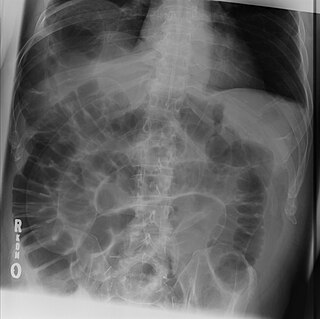Related Research Articles

A disease is a particular abnormal condition that negatively affects the structure or function of all or part of an organism, and that is not due to any immediate external injury. Diseases are often known to be medical conditions that are associated with specific symptoms and signs. A disease may be caused by external factors such as pathogens or by internal dysfunctions. For example, internal dysfunctions of the immune system can produce a variety of different diseases, including various forms of immunodeficiency, hypersensitivity, allergies and autoimmune disorders.

Medicine is the science and practice of establishing the diagnosis, prognosis, treatment, and prevention of disease. Medicine encompasses a variety of health care practices evolved to maintain and restore health by the prevention and treatment of illness. Contemporary medicine applies biomedical sciences, biomedical research, genetics, and medical technology to diagnose, treat, and prevent injury and disease, typically through pharmaceuticals or surgery, but also through therapies as diverse as psychotherapy, external splints and traction, medical devices, biologics, and ionizing radiation, amongst others.

Appendicitis is inflammation of the appendix. Symptoms commonly include right lower abdominal pain, nausea, vomiting, and decreased appetite. However, approximately 40% of people do not have these typical symptoms. Severe complications of a ruptured appendix include widespread, painful inflammation of the inner lining of the abdominal wall and sepsis.
Mittelschmerz is a medical term for "ovulation pain" or "midcycle pain". About 20% of women experience mittelschmerz, some every cycle, some intermittently.
A medical sign is an objective indication of a disease, injury, or abnormal physiological state that may be detected during the physical examination of a patient. These signs can be detectable by anyone, e.g. the temperature or blood pressure of the patient, skin that is redder than usual, or a bruise; others may have no meaning to the patient or may even go completely unnoticed. Medical signs assist a healthcare provider to reach an accurate diagnosis.

The Walter Reed Army Medical Center (WRAMC)—known as Walter Reed General Hospital (WRGH) until 1951—was the U.S. Army's flagship medical center from 1909 to 2011. Located on 113 acres (46 ha) in the District of Columbia, it served more than 150,000 active and retired personnel from all branches of the military. The center was named after Major Walter Reed (1851–1902), an Army physician who led the team that confirmed that yellow fever is transmitted by mosquitoes rather than direct contact.

The Marijuana Policy Project (MPP) is the largest organization working solely on marijuana policy reform in the United States in terms of its budget, number of members, and staff. Its stated aims are to: (1) increase public support for non-punitive, non-coercive marijuana policies; (2) identify and activate supporters of non-punitive, non-coercive marijuana policies; (3) change state laws to reduce or eliminate penalties for the medical and non-medical use of marijuana; and (4) gain influence in Congress. MPP advocates taxing and regulating the possession and sale of marijuana in a manner similar to alcohol, envisions a nation where marijuana education is honest and realistic, and believes treatment for problem marijuana users should be non-coercive and geared toward reducing harm.

Vital signs are a group of the four to six most important medical signs that indicate the status of the body’s vital (life-sustaining) functions. These measurements are taken to help assess the general physical health of a person, give clues to possible diseases, and show progress toward recovery. The normal ranges for a person’s vital signs vary with age, weight, gender, and overall health.
The Diseases Database is a free website that provides information about the relationships between medical conditions, symptoms, and medications. The database is run by Medical Object Oriented Software Enterprises Ltd, a company based in London.

A radiologic sign is an objective indication of some medical fact that is detected by a physician during radiologic examination with medical imaging.
CEN ISO/IEEE 11073 Health informatics - Medical / health device communication standards enable communication between medical, health care and wellness devices and external computer systems. They provide automatic and detailed electronic data capture of client-related and vital signs information, and of device operational data.

For sociological tests, see laboratory studies.For laboratory test, see blood test.

Medical diagnosis is the process of determining which disease or condition explains a person's symptoms and signs. It is most often referred to as diagnosis with the medical context being implicit. The information required for diagnosis is typically collected from a history and physical examination of the person seeking medical care. Often, one or more diagnostic procedures, such as medical tests, are also done during the process. Sometimes posthumous diagnosis is considered a kind of medical diagnosis.

A symptom is a departure from normal function or feeling which is apparent to a patient, reflecting the presence of an unusual state, or of a disease. A symptom can be subjective or objective. Tiredness is a subjective symptom whereas cough or fever are objective symptoms. In contrast to a symptom, a sign is a clue to a disease elicited by an examiner or a doctor. For example, paresthesia is a symptom, whereas erythema is a sign. Symptoms and signs are often nonspecific, but often combinations of them are at least suggestive of certain diagnoses, helping to narrow down what may be wrong. In other cases they are specific even to the point of being pathognomonic.

In the United States, the use and possession of cannabis is illegal under federal law for any purpose, by way of the Controlled Substances Act of 1970. Under the CSA, cannabis is classified as a Schedule I substance, determined to have a high potential for abuse and no accepted medical use – thereby prohibiting even medical use of the drug. At the state level, however, policies regarding the medical and recreational use of cannabis vary greatly, and in many states conflict significantly with federal law.

The legal history of cannabis in the United States began with state-level prohibition in the early 20th century, with the first major federal limitations occurring in 1937. Starting with Oregon in 1973, individual states began to liberalize cannabis laws through decriminalization. In 1996, California became the first state to legalize medical cannabis, sparking a trend that spread to a majority of states by 2016. In 2012, Washington and Colorado became the first states to legalize cannabis for recreational use.
Deafness has varying definitions in cultural and medical contexts. In medical contexts, the meaning of deafness is hearing loss that precludes a person from understanding spoken language, an audiological condition. In this context it is written with a lower case d. It later came to be used in a cultural context to refer to those who primarily communicate through sign language regardless of hearing ability, often capitalized as Deaf and referred to as "big D Deaf" in speech and sign. The two definitions overlap but are not identical, as hearing loss includes cases that are not severe enough to impact spoken language comprehension, while cultural Deafness includes hearing people who use sign language, such as children of deaf adults.
Sunil Pradhan is an Indian neurologist, medical researcher and writer, known for the invention of two electrophysiological techniques. He has also described five medical signs, of which one related to Duchenne muscular dystrophy is known as Pradhan Sign, and the others associated with facioscapulohumeral muscular dystrophy (FSHD) and similar neuro diseases. The Government of India awarded him the Padma Shri, the fourth highest civilian award, in 2014 for his contributions to the field of neuroscience.

The Multinational Medical Coordination Centre/European Medical Command (MMCC/EMC) is a medical coordinating centre in support of the European medical services), and is a unit directly subordinated to the German Armed Forces Joint Medical Service Command and the German Surgeon General. It was formed on 1st April 2018 in the Rhine-Barracks, Koblenz, Germany, where it also has its HQ.
The University of Houston College of Medicine, located in Houston, Texas, is the graduate medical school of the University of Houston. Established by the Texas Legislature in 2019, UH College of Medicine will enroll its first class of 30 students in the fall of 2020.
References
- ↑ Sachdeva, Anupam; Dutta, AK (31 August 2012). Advances in Pediatrics. JP Medical Ltd. p. 1432. ISBN 978-93-5025-777-7.
| This medical sign article is a stub. You can help Wikipedia by expanding it. |